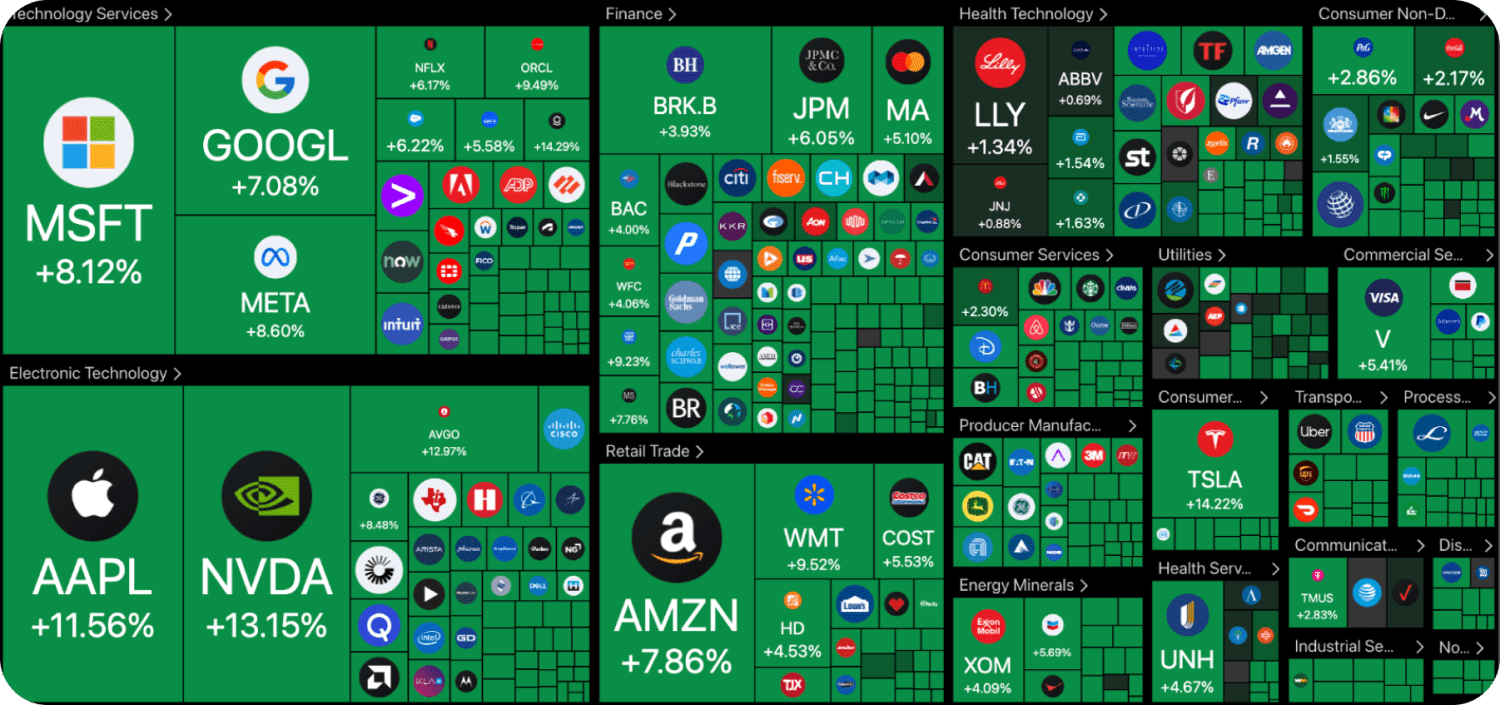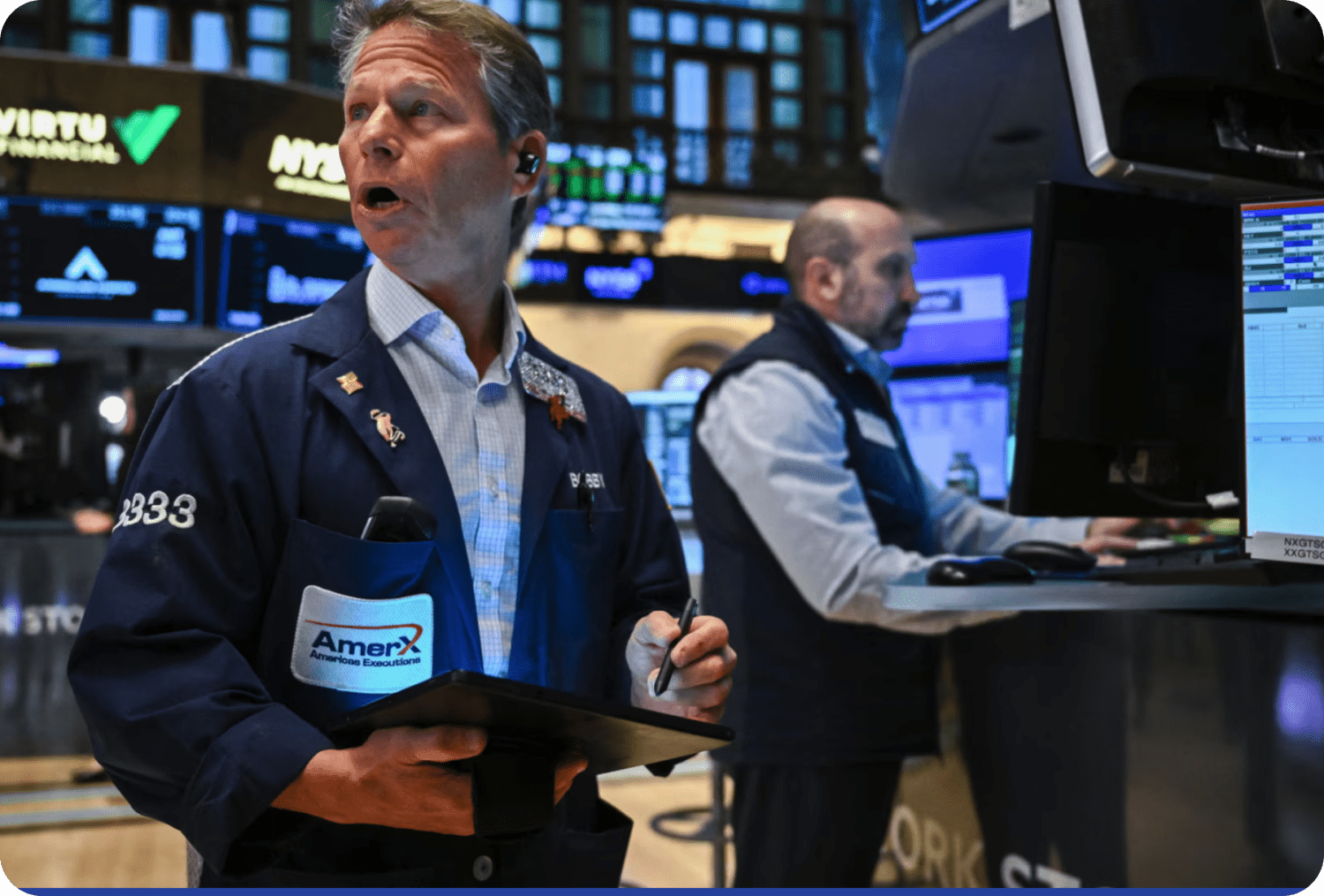This week in crypto felt like a pressure cooker finally bursting.
Trump’s 90-day tariff pause sparked a sudden rally, sending stocks and Bitcoin flying. But despite positive inflation data, markets didn’t react as expected. BTC briefly touched an 11-day high, while Ethereum broke below $1,500, flashing major warning signs. Meanwhile, Ripple made headlines with a $1.25B deal and launched a new ETF, as Trump signed the first-ever crypto bill and a new SEC chair took over—fueling fresh optimism for altcoin ETFs like Solana.
Momentum is building, but uncertainty still rules. Let’s break down the key events shaping the market this week in our weekly crypto news.
Tariff Pause Ignites Markets: BTC and Stocks Soar
On April 9, President Donald Trump announced a 90-day pause on tariffs for most countries—except China, where tariffs were instead raised to 125% in response to its previous countermeasures. The news caused an instant reaction in the markets.

Both stock and crypto prices jumped. Bitcoin (BTC) surged over 5% in less than an hour and ended the day more than 10% higher. The S&P 500 rose 9.52%, marking its third-biggest one-day gain since World War II, while the Nasdaq 100 jumped 12.02%. The biggest moves came in crypto-related stocks—MicroStrategy gained 24.76%, Coinbase rose 17%, and mining companies like MARA, Cipher, and RIOT climbed between 12% and 17%.
Behind this rally, analysts point to one major shift: most short-term sellers have already sold. Over the past weeks, a large number of traders exited the market, which helped reduce risk and calm down extreme price swings. That’s why many now say Bitcoin is in a healthier position to move higher.

Bitcoin briefly reached an 11-day high of around 78.500 € (~86,000 $) after President Trump announced updates to the China tariffs. While China still faces a 125% tariff, the U.S. decided to exclude certain key products from the restrictions, sparking optimism in the markets. The price jump was short-lived, as weekend trading brought lower volume and Bitcoin slipped back under 84.000 $. Despite this, BTC still closed the week up 7%, after rebounding from five-month lows earlier in the week.
Inflation Drops, But Markets Shrug: What’s Next for BTC?
Last week, inflation data from the U.S. came in much lower than expected. The U.S. Consumer Price Index (CPI) and Producer Price Index (PPI), both showed that prices are rising more slowly, which usually means less pressure on interest rates and more room for growth in risk assets like Bitcoin.
Despite this positive news, markets didn’t react with enthusiasm. The S&P 500 and Nasdaq dropped, and Bitcoin also lost momentum, falling back under $84,000. Many experts believe the good news was overshadowed by uncertainty around the ongoing trade war and growing doubts about U.S. economic stability, and uncertainty around interest rate cuts—especially after the probability of a rate cut by September dropped sharply from 97.6% to just 69.7%.

At the same time, investors started selling off U.S. government bonds in a worst selloff since 2019 — a sign that trust in the U.S. economy is slipping. The dollar also weakened, falling to its lowest level since 2022. which made people question whether traditional assets were still the safest option.
Still, many investors see this setup as a bullish one for Bitcoin. A weaker dollar has often led to strong Bitcoin rallies in the past. And with the Federal Reserve expected to cut interest rates several times this year, more people are turning to Bitcoin as an alternative investment. Former BitMEX CEO Arthur Hayes even said we’re entering “up only mode” as the current economic conditions could push the Fed to act.
Ethereum Under Pressure as Price Slips Below $1,500
Ethereum (ETH) has been struggling this week, falling below the $1,500 mark and hitting its lowest level since 2022. The drop wiped out nearly seven years of gains and has raised concerns about where the second-largest cryptocurrency is headed next.

While Bitcoin has shown relative strength, Ethereum is losing ground. Network activity is weakening—active wallet numbers haven’t grown in four years, and more users are shifting to competing blockchains like Solana, BNB Chain and Tron. At the same time, ETH’s price has fallen below its realized price, a metric that often signals that many holders are now underwater and losing confidence.
Investor sentiment isn’t helping. Spot Ethereum ETFs have seen over $94 million in outflows in just the last two weeks, and derivatives data shows open interest is down 48% from January highs. Funding rates also remain negative, suggesting most traders are betting against the price.
Technical analysts now warn that ETH may not have found a bottom yet. If bearish momentum continues and no strong buying interest returns, Ethereum could slide further—potentially toward the $1,000 level seen in previous market cycles.
XRP Surges as Ripple Buys Hidden Road, Launches XXRP ETF

Ripple (XRP) is making bold moves in 2025. On April 8, the company confirmed it’s acquiring crypto-friendly prime broker Hidden Road for $1.25 billion—one of the biggest crypto M&A deals to date. The goal? To become the largest non-bank prime broker and expand the use of its stablecoin RLUSD and XRP Ledger (XRPL).
The acquisition is expected to shift over $3 trillion in annual clearing volume from traditional markets to Ripple’s ecosystem. Ripple CEO Brad Garlinghouse called the deal a “once-in-a-lifetime” opportunity to bridge crypto and traditional finance, and Ripple CTO David Schwartz described it as a “defining moment” for XRPL adoption.
At the same time, Ripple launched the XXRP ETF, a 2x leveraged product listed on the NYSE Arca. It opened with $5 million in first-day volume—solid by ETF standards—and helped push XRP price up 13%, briefly reclaiming the $2 level.
IRS DeFi Rule Killed, New SEC Chair Confirmed, Solana Surges

In a landmark move, President Trump signed a resolution on April 10 to overturn the controversial IRS DeFi broker rule. The law, set to take effect in 2027, would have forced decentralized platforms to report user transaction data to the IRS. Lawmakers said the rule was overly burdensome and threatened crypto innovation.
Just days earlier, Paul Atkins was confirmed as the new SEC Chair. Known for his market-friendly stance, Atkins is expected to bring clearer rules for digital assets. His appointment has sparked optimism across the crypto sector.
That includes Solana. The approval odds for a Solana ETF jumped to 76% after Atkins’ confirmation, with multiple asset managers—including VanEck and Grayscale—already filing applications. Investors are betting the new SEC leadership could clear the way for altcoin ETFs.
The week kicked off in the red as tariffs officially took effect, sparking fear across global markets. But just as quickly, sentiment flipped—Trump’s tariff pause triggered a sharp rally in both stocks and crypto. Still, with inflation signals mixed, Ethereum weakening, and policy uncertainty ahead, volatility is far from over.
For those navigating the chaos—well done. Weeks like these are where conviction is built. Stay focused, stay informed, and remember: even in uncertain markets, consistent strategy beats panic every time.





